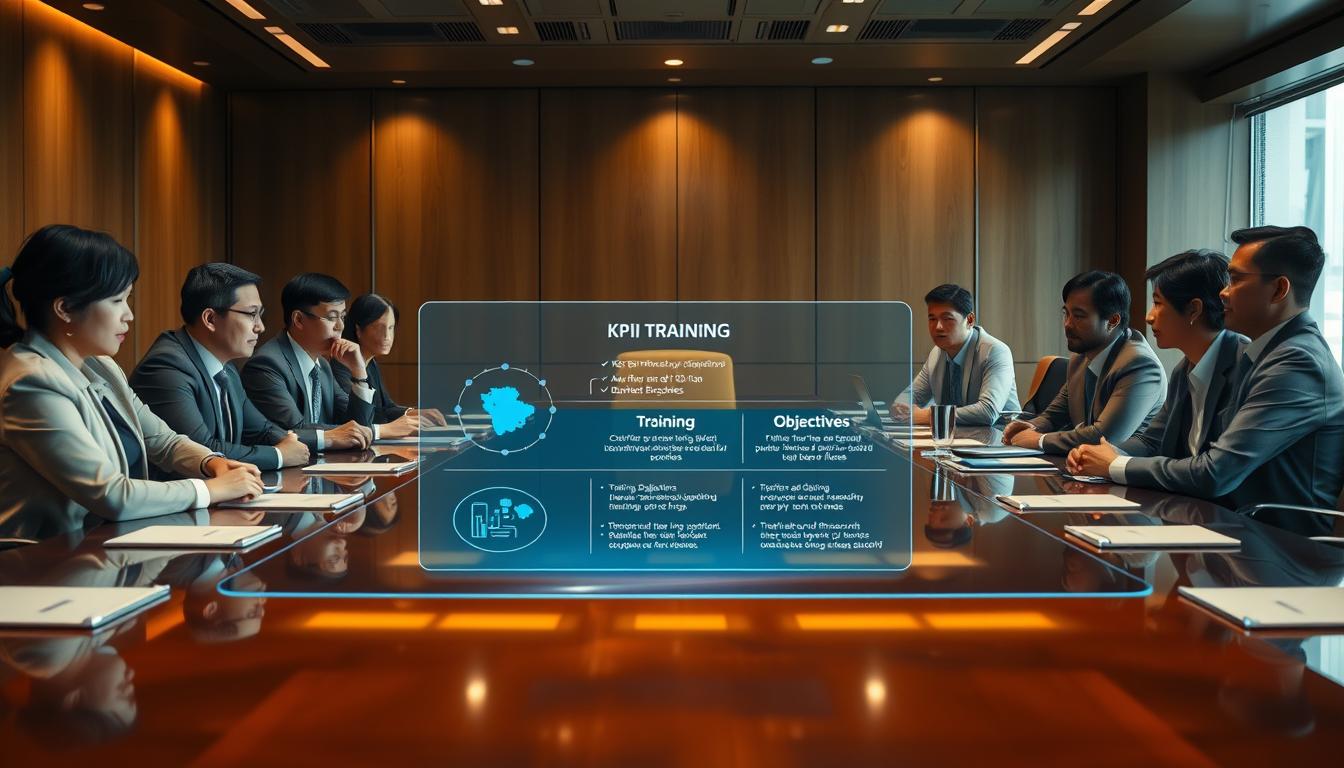Are you sure your ERP training program is working as it should? Or is it quietly failing? It’s vital to check if your User Training & Onboarding is effective, more so in the Philippines. Here, using time and resources wisely is key to success.
Studies show that about 75% of ERP projects fail because of bad training. It’s not just about training; it’s about seeing if it works. This article will show you how to check if your training is doing the job.
Key Takeaways
- Understanding the importance of assessing training programs.
- Setting clear training objectives aligned with business goals.
- Identifying user roles for a more targeted training approach.
- Implementing surveys and interviews for accurate competence assessment.
- Leveraging technology and various training methods for better engagement.
- Continuously analyzing feedback and performance for improvement.
Understanding the Importance of ERP Training Evaluation
ERP training evaluation is key to seeing how well users take to new systems. In the Philippines, businesses see big wins when they match their training with their goals. This makes the transition smoother and boosts user happiness.
By checking how well their training works, companies can find out what’s good and what needs work. They can use feedback to make their training better. This leads to better learning and more productivity.
The success of an ERP system relies on users being able to use it easily. Regular checks on training make sure users are happy. This leads to a cycle of getting better at training, always ready to meet new needs.
| Aspect | Impact of ERP Training Evaluation |
|---|---|
| User Satisfaction | Increased by tailoring training programs to user feedback |
| Training Improvement | Enhanced through ongoing assessment and adaptation of methods |
| Business Outcomes | Boosted productivity and efficiency as users become more competent |
Defining Clear Goals for Your Training Program
Creating an effective ERP training program starts with clear goals. Aligning training objectives with measurable business outcomes helps streamline efforts. This ensures resources are used efficiently, focusing on what truly matters.
Aligning Training Objectives with Business Outcomes
Training objectives that support specific business outcomes lead to significant improvements. For example, Globe Telecom aims to cut operational costs through training. PLDT aims to boost customer service by training employees to use ERP systems well. These goals help improve business performance.
Key Performance Indicators (KPIs) to Measure Success
Key Performance Indicators (KPIs) are crucial for evaluating training success. They track user engagement and error rates, showing training progress. For instance, better user skills mean training goals are met, leading to better business outcomes. Setting the right KPIs helps refine strategies for ERP success.
| Training Objective | Associated Business Outcome | KPI |
|---|---|---|
| Reduce Operational Costs | Increase Profit Margins | Cost per Transaction |
| Improve Customer Service | Higher Customer Satisfaction | Customer Satisfaction Score (CSAT) |
| Enhance User Proficiency | Increased Productivity | Task Completion Rate |
Analyzing User Groups and Roles
Understanding user groups is key for a good ERP training program. These groups have different job functions and knowledge needs. Making training fit these needs makes the ERP system better for everyone.
Segmenting Users by Job Function and ERP Module
Segmenting users by job helps find out what training they need. For example, factory workers at Ayala Corporation need training on manufacturing. On the other hand, the finance and human resources teams need a broad understanding. Knowing these needs helps in making training more effective.
Identifying Different Skill Levels and Learning Needs
It’s important to know the skill levels in each group. Some users might already know the ERP system, while others need to learn from scratch. By meeting these different needs, training becomes more effective. This leads to better use and satisfaction of the system.
Conducting a Skills Gap Analysis
Doing a skills gap analysis is key to knowing what skills your team has. It helps find out where more training is needed. This way, your team can use the ERP system better, making your work more efficient.
Assessing Current Competencies of Your Users
First, you need to see what your team can do. You can use reviews and maps to check their skills. Knowing who’s good at what lets you make training that really helps.
Utilizing Surveys and Interviews for Insights
Surveys and talks with your team give you real feedback. They show how comfortable and skilled your team is with the ERP system. For example, talking to teams at SM Investments Corporation can show what they need to learn. This makes sure your team can use the system well.
Choosing Effective Training Methods and Tools
Choosing the right training methods and tools is key for a successful ERP training program. Different methods fit different learning styles, helping users learn and understand new skills. Companies like Jollibee Foods Corporation see better results by using many training formats. This makes learning more engaging and helps users remember what they learn.
Exploring Various Training Formats
Offering many training formats meets the needs of all learners. Here are some effective formats to consider:
- Hands-on workshops: Give users practical experience in a safe setting.
- Online courses: Let users learn at their own pace, fitting their schedules.
- Self-paced videos: Allow users to learn at their own speed, reinforcing concepts as needed.
Leveraging Technology for Enhanced Learning
Technology makes learning more dynamic and accessible. Using mobile apps and interactive e-learning platforms boosts user engagement. It lets training happen anywhere, whether at work or from home. This tech integration improves learning outcomes and user satisfaction, leading to a more skilled workforce.
User Training & Onboarding Strategies for Success
Success in ERP training depends on good user training and onboarding. Engaging and practical training materials are key. They help trainees connect with the content, making learning better.
Using real-world examples from local and global companies adds value. This method keeps users interested and teaches them skills they can use right away.
Creating Engaging and Practical Training Materials
Make training materials clear and interactive. They should be easy to understand and keep users interested. Adding videos and quizzes can make learning more fun.
Customize content for different roles in your company. This way, everyone gets the right information. It helps them remember and use what they learn.
Implementing Hands-On Training and Simulations
Hands-on training gives users real experience. Simulations let them practice in scenarios they might face. This is super helpful in fields like logistics and sales.
It builds confidence and improves skills. Users can apply what they learn in their daily work.
Evaluating the Impact of Your ERP Training Program
It’s key to check how well an ERP training program works. This starts with tests before and after the training. These training assessments show how much the program helped the company and guide future training.
Pre- and Post-Training Assessments
Tests before the training show what people already know. Then, tests after show how much they’ve learned. This helps see how much the training helped and where it can improve.
Gathering Feedback and Measuring User Adoption
Getting feedback from those who took the training is very important. Surveys and talks can tell us a lot about how well the training worked. By watching how well people use what they learned, companies can make their training even better.
Providing Ongoing Support and Resources
It’s key to offer ongoing support to help users understand and keep what they learn from ERP training. A strong support system makes it easy for employees to ask for help. This way, they can better understand the ERP system.
Creating a culture that values continuous learning is crucial. When companies show that learning never stops, they open doors for more growth. This makes employees more skilled and confident in using the ERP system.
Being part of user communities can really boost learning. Joining groups, like local ERP forums in the Philippines, lets employees share their experiences. These communities help with peer support, making everyone understand the ERP system better.
For more tips on support in the Philippines, check out this resource. Combining ongoing support, a culture of learning, and user communities creates a great environment. It benefits both the company and its workers.
Utilizing Analytics for Continuous Improvement
In today’s world, using analytics is key for bettering your ERP training. By watching how users engage and perform, you can see what works and what doesn’t. This helps pinpoint areas to improve, making your training more effective.
Tracking User Engagement and Performance Metrics
Tracking how users interact with your training is crucial. Metrics like completion rates and time on modules show how well users are doing. Analytics also help see if training leads to real-world success.
Identifying Areas for Enhancement Based on Data
Analytics uncover trends and patterns that might not be seen without deep analysis. Tools help find out which training parts work best and which need work. Feedback from users helps make smart choices for ongoing improvement.
Conclusion
Evaluating your ERP training program is key to growing your user base and success. By setting clear goals and identifying skills gaps, you create a supportive environment. This makes users confident and skilled.
Choosing the right training methods and offering ongoing support is also important. It helps users in the Philippines use your ERP system to its fullest. This boosts their skills and helps your business grow.
The work on ERP training doesn’t stop after the first launch. It’s a continuous effort to keep improving and adapting. This ensures your users and your business stay ahead.




